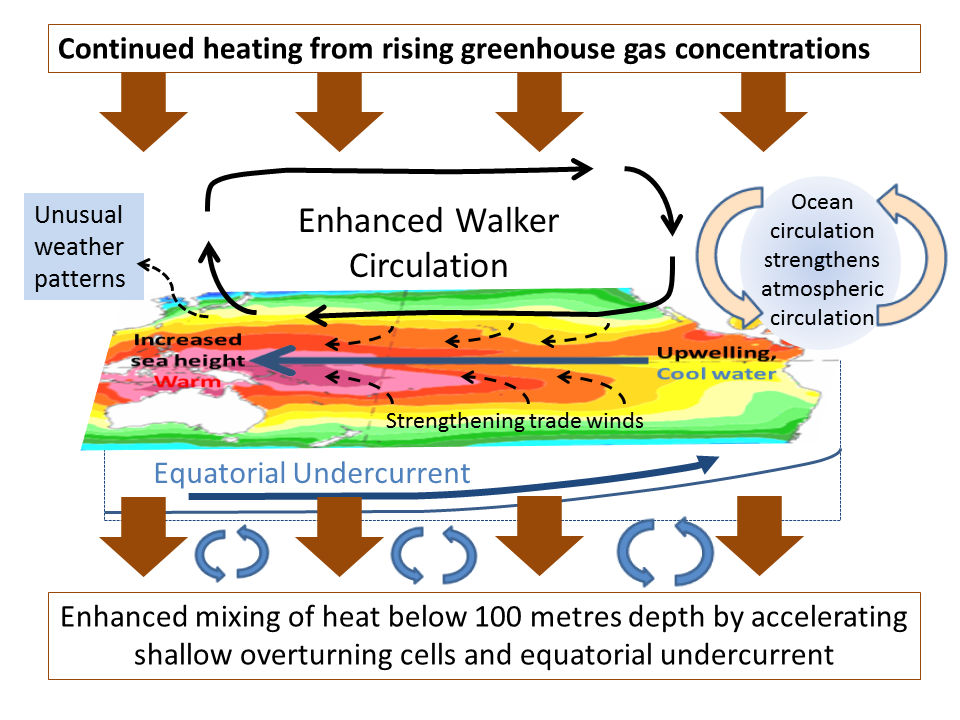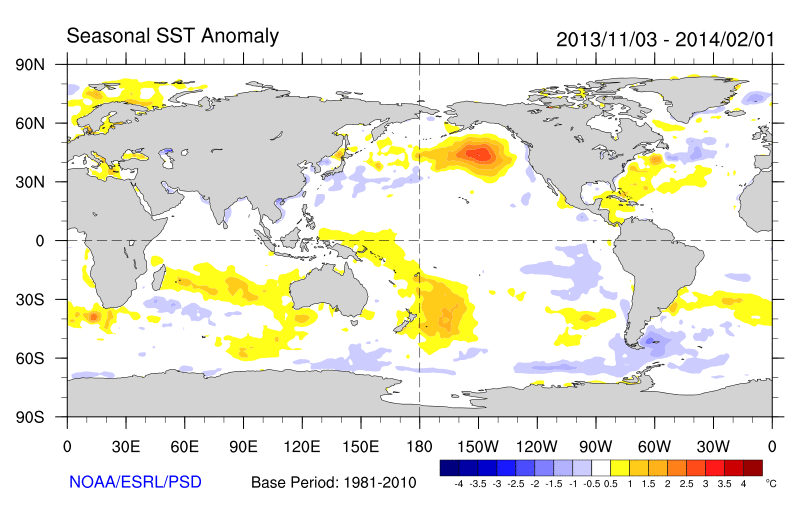February 2014:
Strengthening Walker circulation and the global warming hiatus
New research in Nature Climate Change by England et al. builds upon a number of previous studies implicating the role of the Pacific ocean circulation in explaining the recent slowing of the rise in global average surface temperatures. Using observations and simulations, they demonstrate that an observed strengthening of the Pacific trade winds (which blow from east to west) since the mid-1990s has caused the observed continued heating of the planet (primarily caused by rising atmospheric greenhouse gas concentrations) to be mixed deeper into the ocean rather than warming the surface layers which influence air temperature.

Above: schematic representation of how strengthened atmospheric and oceanic circulations are mixing heat (building up from rising atmospheric concentrations of greenhouse gases) to deeper layers of the Pacific ocean
This new work builds upon previous findings highlighted an increase in sea surface height in the west Pacific caused by strengthening trade winds as part of an intensified Walker circulation across the Pacific with associated upwelling cooling the East Pacific. This region was recently found to be crucial in determining the slowdown in global surface temperature rise.
There is a growing consensus that natural fluctuations in Pacific ocean circulation over many decades (named the Interdecadal Pacific Oscillation or IPO) can contribute positively or negatively to trends in global surface temperature. Climate model simulations can also generate this type of variability in the ocean although are not designed to predict the timing of the lumps and bumps in the temperature record. Previous work has shown that hiatus decades are captured by simulations including increasing greenhouse gas concentrations and that the mechanism is consistent with the England et al. work, namely that heat is increasingly mixed below the ocean surface layers (deeper than 100-300 metres) in the negative phase of the IPO
What is novel about the current work by England et al. is that they construct a simulation which isolates the effect of the increasing wind strength on the mixing of heat into the ocean. Furthermore, they find that while climate models can capture this type of variability, they cannot reproduce the size of the strengthening in trade winds which appear unprecedented in the observational record. What is also intriguing is that these changes are the opposite to the anticipated long term decline in the atmospheric "Walker" circulation in a warming world based upon robust physics and detailed simulations.
An important question, not tackled by the recent study, is: why are these winds increasing? The sea surface patterns generated by the increasing trade winds cause waters to cool in the east Pacific and warm in the west Pacific which in turn can drive further strengthening in the trade winds: a vicious cycle. Therefore it is somewhat of a chicken and egg problem; which is driving which? And are these unprecedented changes associated with rising greenhouse gases or changes in other radiative forcings such as aerosol pollution or solar irradiance? Or are they generated by unforced, chaotic (but slow) fluctuations of the ocean?

The implications or these changes could be substantial. It would be surprising if these large changes in atmospheric and ocean circulation over the last 2 decades (including also a potentially long-term decline in the Atlantic ocean circulation), have not already disrupted our weather patterns. The map shows this seasons sea surface temperature departures from normal (from NOAA), with a cool East Pacific and unusual patterns over the north Pacific and north Atlantic that are associated with this seasons extreme weather, including drought in California, intense cold in eastern north America and flooding in the UK and Europe. It is unknown at present how long this strengthening of the Pacific trade winds will continue. Constructing projections of the future, the authors find that the current hiatus in global surface temperature will continue as long as the trade winds continue to strengthen. However, following an expected reversal of the trend, the planet can expect rapid warming of the surface to resume in response to the continued rises in greenhouse gas concentrations.
Richard P. Allan Location: Department of Meteorology (2U15)